Bird R.B., Stewart W.E., Lightfoot E.N. Transport Phenomena
Подождите немного. Документ загружается.

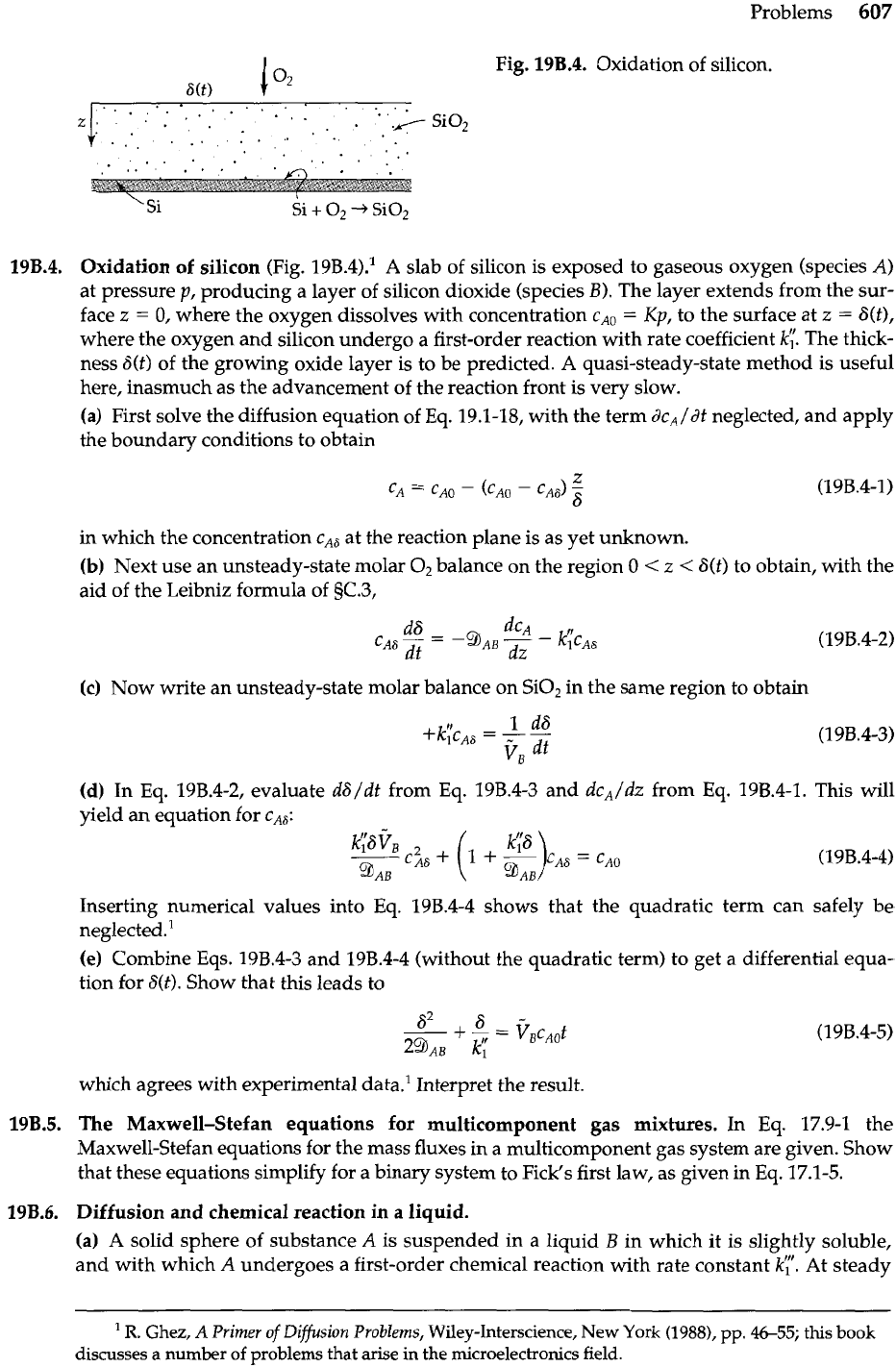
Problems
607
Fig.
198.4.
Oxidation of silicon.
19B.4.
Oxidation of silicon (Fig. 19B.4).'
A
slab of silicon is exposed to gaseous oxygen (species
A)
at pressure p, producing a layer of silicon dioxide (species
B).
The layer extends from the sur-
face
z
=
0, where the oxygen dissolves with concentration
CAO
=
Kp, to the surface at
z
=
SW,
where the oxygen and silicon undergo a first-order reaction with rate coefficient
k;(.
The thick-
ness 6(t) of the growing oxide layer is to be predicted. A quasi-steady-state method is useful
here, inasmuch as the advancement of the reaction front is very slow.
(a)
First solve the diffusion equation of Eq. 19.1-18, with the term dc,/dt neglected, and apply
the boundary conditions to obtain
in which the concentration
CAS
at the reaction plane is as yet unknown.
(b)
Next use an unsteady-state molar
0,
balance on the region 0
<
z
<
6(t) to obtain, with the
aid of the Leibniz formula of gC.3,
(c)
Now write an unsteady-state molar balance on SiO, in the same region to obtain
(d)
In Eq. 19B.4-2, evaluate dS/dt from Eq. 19B.4-3 and dc,/dz from
Eq.
19B.4-I. This will
yield an equation for
CA,:
Inserting numerical values into Eq. 19B.4-4 shows that the quadratic term can safely be
neglected.
'
(e)
Combine Eqs. 19B.4-3 and 19B.4-4 (without the quadratic term) to get a differential equa-
tion for S(t). Show that this leads to
which agrees with experimental data.' Interpret the result.
19B.5.
The Maxwell-Stefan equations
for
multicomponent gas mixtures. In Eq. 17.9-1 the
Maxwell-Stefan equations for the mass fluxes in a multicomponent gas system are given. Show
that these equations simplify for a binary system to Fick's first law, as given in Eq. 17.1-5.
19B.6.
Diffusion and chemical reaction in a liquid.
(a) A solid sphere of substance
A
is suspended in
a
liquid
B
in which it is slightly soluble,
and with which
A
undergoes a first-order chemical reaction with rate constant
ky.
At steady
'
R.
Ghez,
A
Primer
of
Diffusion
Problems,
Wiley-Interscience,
New
York
(1988),
pp.
46-55;
this book
discusses
a
number of problems that arise in the microelectronics field.
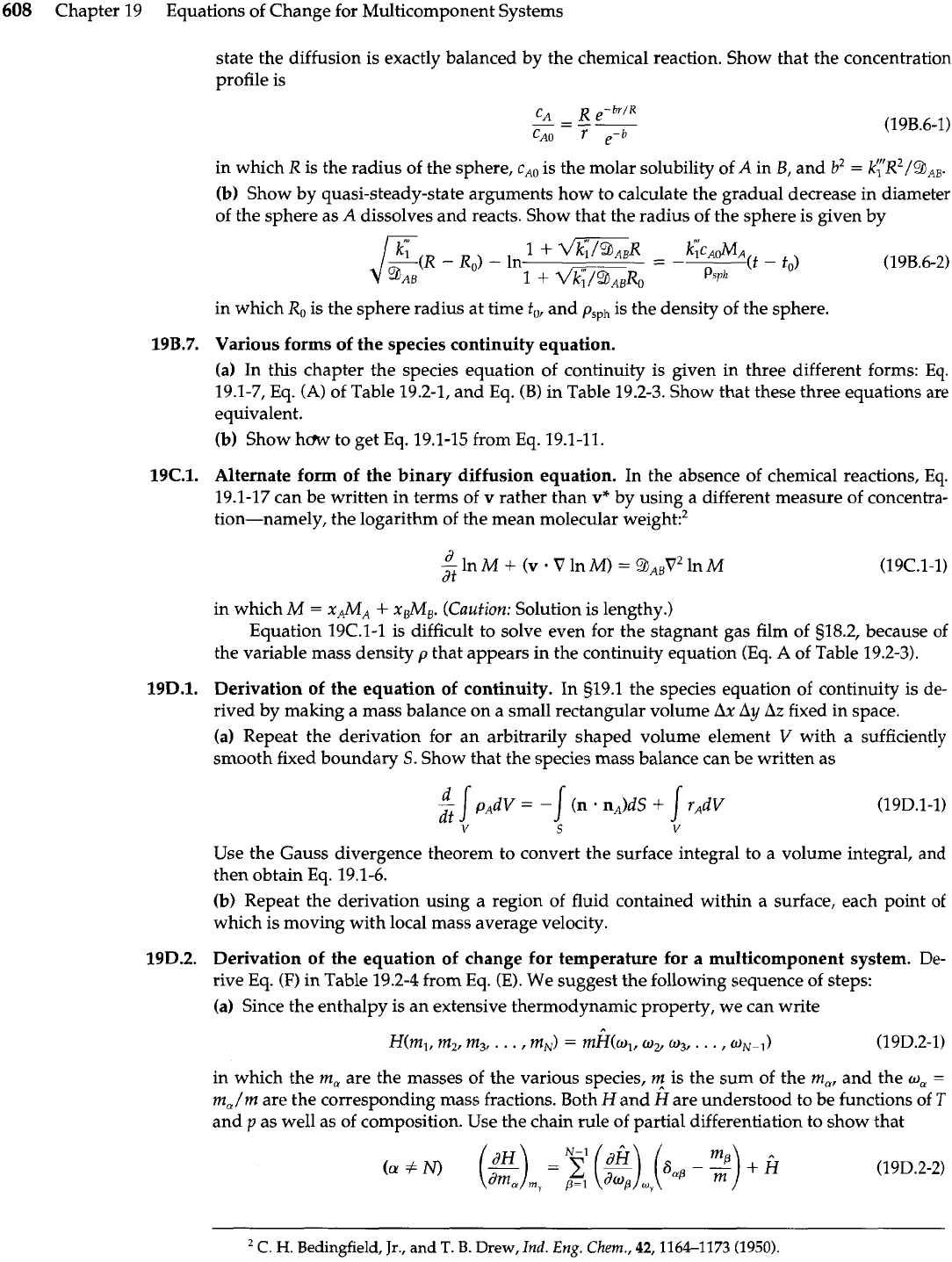
608
Chapter 19 Equations of Change for Multicomponent Systems
state the diffusion is exactly balanced by the chemical reaction. Show that the concentration
profile is
in which
R
is the radius of the sphere,
cAo
is the molar solubility of
A
in
B,
and
b2
=
kyR2/9,,.
(b) Show by quasi-steady-state arguments how to calculate the gradual decrease in diameter
of the sphere as
A
dissolves and reacts. Show that the radius of the sphere is given by
in which
Ro
is the sphere radius at time to, and
p,,,
is the density of the sphere.
19B.7.
Various forms of the species continuity equation.
(a) In this chapter the species equation of continuity is given in three different forms:
Eq.
19.1-7, Eq.
(A)
of Table 19.2-1, and
Eq.
(B) in Table 19.2-3. Show that these three equations are
equivalent.
(b) Show hdv to get Eq. 19.1-15 from Eq. 19.1-11.
19C.1. Alternate form of the binary diffusion equation. In the absence of chemical reactions, Eq.
19.1-17 can be written in terms of v rather than v* by using a different measure of concentra-
tion-namely, the logarithm of the mean molecular weight:'
in which
M
=
xAMA
+
xBMB.
(Caution:
Solution is lengthy.)
Equation 19C.1-1 is difficult to solve even for the stagnant gas film of 518.2, because
of
the variable mass density
p
that appears in the continuity equation (Eq.
A
of Table 19.2-3).
19D.1. Derivation of the equation of continuity. In
s19.1
the species equation of continuity is
de-
rived by making a mass balance on a small rectangular volume
Ax
Ay
Az
fixed in space.
(a) Repeat the derivation for an arbitrarily shaped volume element
V
with a sufficiently
smooth fixed boundary
S.
Show that the species mass balance can be written as
Use the Gauss divergence theorem to convert the surface integral to a volume integral, and
then obtain Eq. 19.1-6.
(b) Repeat the derivation using a region of fluid contained within a surface, each point
of
which is moving with local mass average velocity.
19D.2. Derivation of the equation of change for temperature for a multicomponent system.
De-
rive Eq.
(F)
in Table 19.2-4 from Eq. (E). We suggest the following sequence of steps:
(a) Since the enthalpy is an extensive thermodynamic property, we can write
in which the
m,
are the masses of the various species, is the sum of the
ma,
and the
w,
=
m,/m
are the corresponding mass fractions. Both Hand Hare understood to be functions of
T
and
p
as well as of composition. Use the chain rule of partial differentiation to show that
C.
H.
Bedingfield,
Jr.,
and
T.
8.
Drew,
Ind.
Eng.
Chem.,
42,1164-1173 (1950).
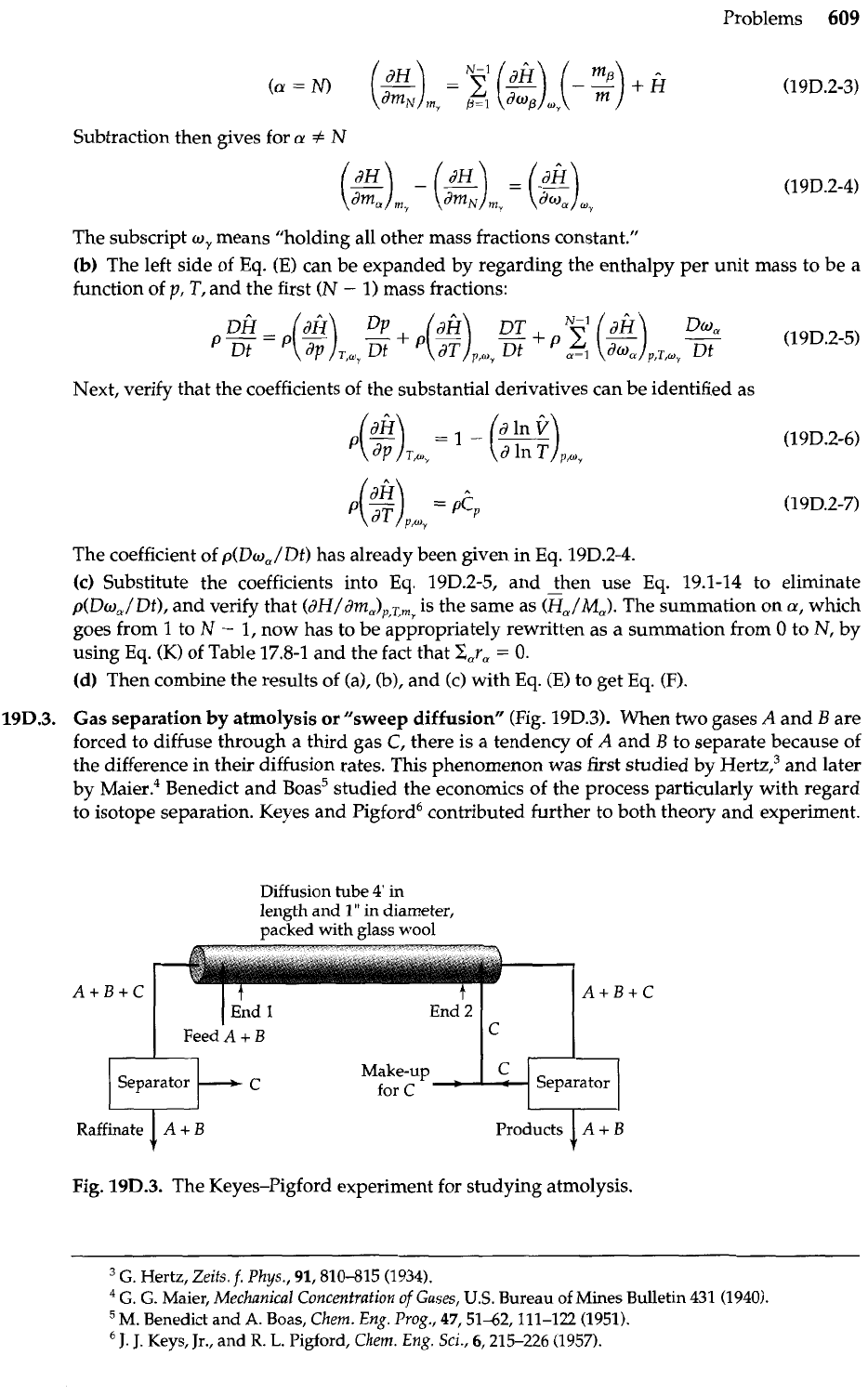
Problems
609
Subtraction then gives for
a
#
N
The subscript
w,
means "holding all other mass fractions constant."
(b) The left side of
Eq.
(E)
can be expanded
by
regarding the enthalpy per unit mass to be a
function of
p,
T,
and the first (N
-
1)
mass fractions:
Next, verify that the coefficients of the substantial derivatives can be identified as
The coefficient of p(Dw,/
Dt)
has already been given in
Eq.
19D.2-4.
(c)
Substitute the coefficients into
Eq.
19D.2-5,
and then use Eq.
19.1-14
to eliminate
p(Dw,/Dt), and verify that (dH/dma)p,T,,y is the same as (HJM,). The summation on
a,
which
goes from
1
to
N
-
1,
now has to be appropriately rewritten as
a
summation from
0
to N, by
using
Eq.
(K)
of Table
17.8-1
and the fact that Z,ra
=
0.
(d)
Then combine the results of (a),
(b),
and (c) with
Eq.
(E) to get
Eq.
(F).
19D.3.
Gas separation by atmolysis or
"sweep
diffusion"
(Fig.
19D.3).
When two gases
A
and
B
are
forced to diffuse through a third gas
C,
there is a tendency of
A
and
B
to separate because of
the difference in their diffusion rates. This phenomenon was first studied by Hertz? and later
by Maier.* Benedict and Boas5 studied the economics of the process particularly with regard
to isotope separation. Keyes and pigford6 contributed further to both theory and experiment.
Diffusion tube
4'
in
length and 1
"
in diameter,
packed with glass
wool
A+B+C A+B+C
,
1
1 ~ni'2
I
Cc
,
1
,
Feed
A
+
B
Make-up
Separator for
C
Separator
Raffinate
A
+
B
I
Products
A
+
B
I
Fig.
19D.3.
The Keyes-Pigford experiment for studying atmolysis.
G.
Hertz,
Zeits.
f.
Phys.,
91,810-815 (1934).
G. G.
Maier,
Mechanical Concentration
of
Gases,
US.
Bureau of Mines Bulletin 431 (1940).
M.
Benedict and
A.
Boas,
Chem. Eng. Prog.,
47,5142,111-122 (1951).
J.
J.
Keys,
Jr.,
and
R.
L.
Pigford,
Chem. Eng.
Sci.,
6,215-226 (1957).
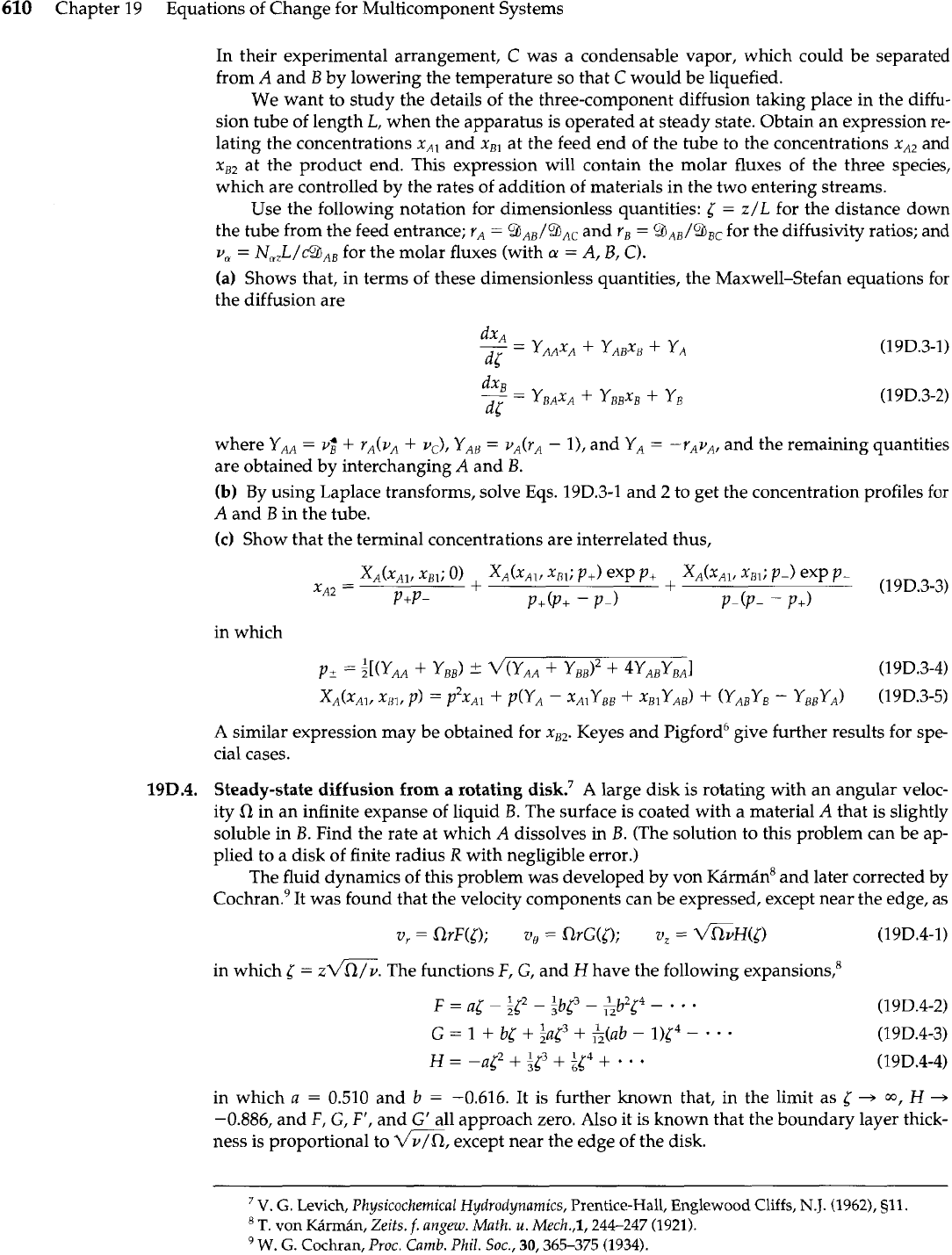
610
Chapter
19
Equations of Change for Multicomponent Systems
In their experimental arrangement,
C
was a condensable vapor, which could be separated
from
A
and
B
by lowering the temperature so that
C
would be liquefied.
We want to study the details of the three-component diffusion taking place in the diffu-
sion tube of length
L,
when the apparatus is operated at steady state. Obtain an expression
re-
lating the concentrations x,, and xB1 at the feed end of the tube to the concentrations
X,q
and
xB2 at the product end. This expression will contain the molar fluxes of the three species,
which are controlled by the rates of addition of materials in the two entering streams.
Use the following notation for dimensionless quantities:
5
=
z/L
for the distance down
the tube from the feed entrance; rA
=
9lAB/BAc and
r,
=
gAB/9BC
for the diffusivity ratios; and
v,
=
N,,L/c~~~ for the molar fluxes (with
a
=
A,
B,
C).
(a) Shows that, in terms of these dimensionless quantities, the Maxwell-Stefan equations for
the diffusion are
where
YAA
=
vz
+
rA(vA
+
vC),
YAS
=
vA(rA
-
I),
and
YA
=
-YAVA, and the remaining quantities
are obtained by interchanging
A
and
B.
(b)
By using Laplace transforms, solve Eqs.
19D.3-1
and
2
to get the concentration profiles for
A
and
B
in the tube.
(c)
Show that the terminal concentrations are interrelated thus,
XA(~AI, XRI;
0)
+
XA(~AI, xm;
p+)
exp
p+
XA(xA1,
r,,;
p-)
exp
p-
X~2
=
P+P-
+
p+(p+
-
p-)
(19D.3-3)
P-(P-
-
p+)
in which
A
similar expression may be obtained for
xB2.
Keyes and Pigford6 give further results for spe-
cial cases.
19D.4.
Steady-state diffusion from a rotating disk.7
A
large disk is rotating with an angular veloc-
ity
fl
in an infinite expanse of liquid
B.
The surface is coated with a material A that is slightly
soluble in
B.
Find the rate at which A dissolves in
B.
(The solution to this problem can be ap-
plied to a disk of finite radius
R
with negligible error.)
The fluid dynamics of this problem was developed by von KBrmBn8 and later corrected by
C~chran.~ It was found that the velocity components can be expressed, except near the edge, as
in which
5
=
zmv.
The functions F,
G,
and
H
have the following expansions:
in which
a
=
0.510
and
b
=
-0.616.
It is further known that, in the limit as
l
+
m,
H
+
-0.886,
and
F,
G,
F',
and
G'
all approach zero. Also it is known that the boundary layer thick-
ness is proportional to
m,
except near the edge of the disk.
'
V.
G.
Levich,
Physicochemical Hydrodynamics,
Prentice-Hall, Englewood
Cliffs,
N.J.
(1962),
§11.
T.
von
Kirmhn,
Zeits.
f.
angew.
Math.
u.
Mech.,l,
244-247
(1921).
W.
G.
Cochran,
Proc.
Camb. Phil.
Soc.,
30,365-375
(1934).
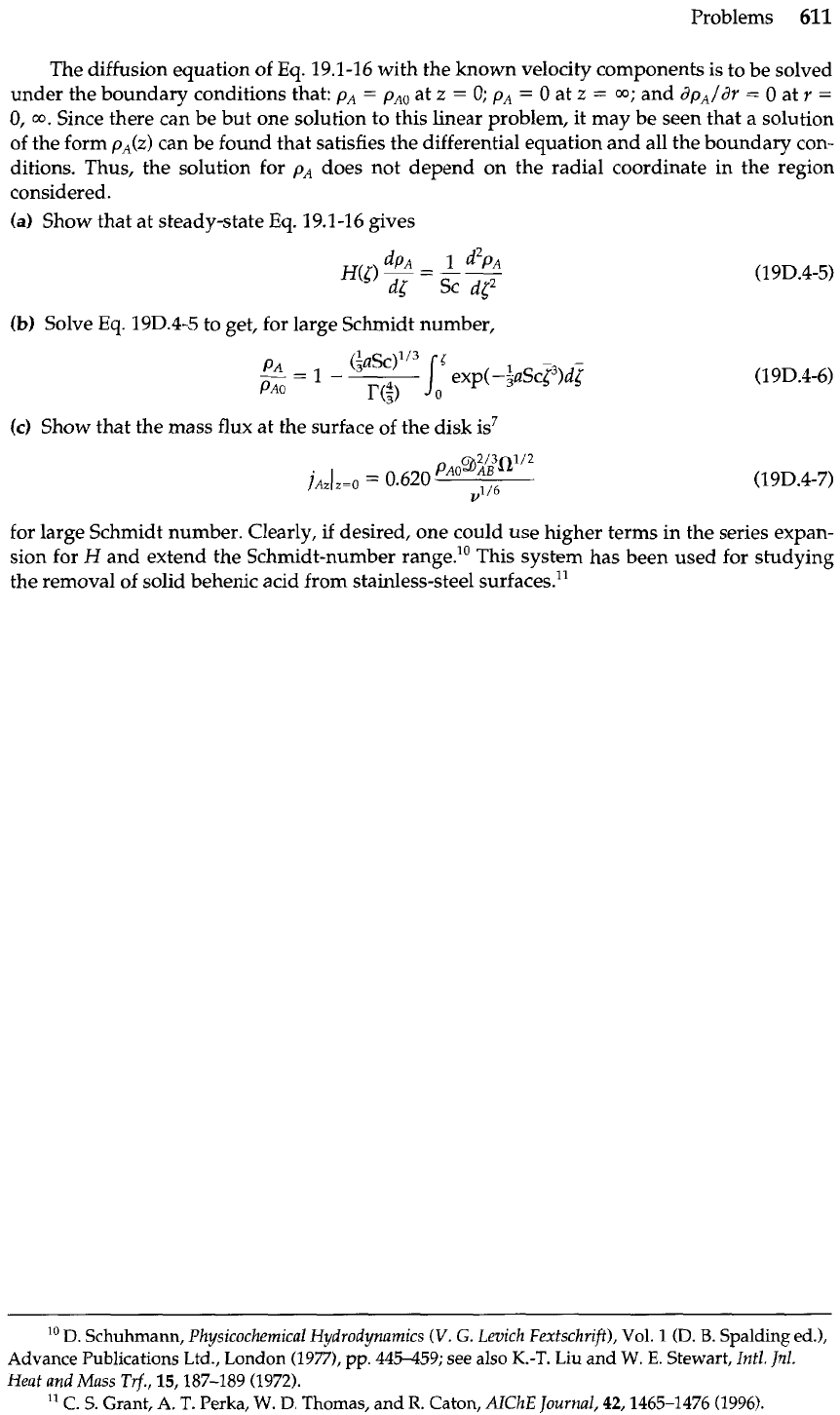
Problems
611
The diffusion equation of Eq. 19.1-16 with the known velocity components is to be solved
under the boundary conditions that:
p,
=
p,,
at
z
=
0;
p,
=
0
at
z
=
m;
and
dp,/dr
=
0
at
r
=
0,
m.
Since there can be but one solution to this linear problem, it may be seen that a solution
of the form
p,(z)
can be found that satisfies the differential equation and all the boundary con-
ditions. Thus, the solution for
p~
does not depend on the radial coordinate in the region
considered.
(a)
Show that at steadystate
Eq.
19.1-16 gives
(b)
Solve
Eq.
19D.4-5 to get, for large Schmidt number,
(c)
Show that the mass flux at the surface of the disk is7
for large Schmidt number. Clearly, if desired, one could use higher terms in the series expan-
sion for
H
and extend the Schmidt-number range.10 This system has been used for studying
the removal of solid behenic acid from stainless-steel surfaces."
10
D.
Schuhmann,
Physicochemical Hydrodynamics
(V.
G.
Levich Fextschrift),
Vol.
1 (D.
B.
Spalding ed.),
Advance Publications Ltd., London
(1977),
pp.
44.5459;
see also
K.-T.
Liu
and
W.
E.
Stewart,
Intl.
Jnl.
Heat and Mass
Trf.,
15,187-189 (1972).
"
C.
S.
Grant,
A.
T.
Perka,
W.
D.
Thomas, and
R.
Caton,
AIChE
Journal,
42,1465-1476 (1996).

Chapter
20
Concentration Distributions
with More Than One
Independent Variable
520.1 Time-dependent diffusion
520.2~ Steady-state transport in binary boundary layers
520.3.
Steady-state boundary layer theory for flow around objects
520.4. Boundary layer mass transport with complex interfacial motion
520.5. Taylor dispersion in laminar tube flow
Most of the diffusion problems discussed in the preceding two chapters led to ordinary
differential equations for the concentration profiles. In this chapter we use the general
equations of Chapter 19 to set up and solve some diffusion problems that lead to partial
differential equations.
A
large number of diffusion problems can be solved by simply looking up the solu-
tions to the analogous problems in heat conduction. When the differential equations and
the boundary and initial conditions for the diffusion process are of exactly the same form
as those for the heat conduction process, then the heat conduction solution may be taken
over with appropriate changes in notation. In Table 20.0-1 the three main heat transport
equations used in Chapter 12 are shown along with their mass transport analogs. Many
solutions to the nonflow equations may be found in the monographs of Carslaw and
Jaeger' and of Crank.'
Because the diffusion problems described by the equations in Table 20.0-1 are analo-
gous to the problems of Chapter 12, we do not discuss them extensively here. Instead,
we focus primarily on problems involving diffusion with chemical reactions, diffusion
with a moving interface, and diffusion with rapid mass transfer.
In 920.1 we discuss a variety of time-dependent diffusion problems. In s20.2 we pre-
sent some steady-state boundary layer problems involving binary mixtures. This is fol-
lowed by two boundary layer analyses for more complicated systems: the diffusion in
steady flow around arbitrary objects in 920.3, and the diffusion in flows yvith complex in-
terfacial motion in 920.4. Finally, in
520.5
we explore an asymptotic solution to the "Tay-
lor dispersion" problem.
H.
S.
Carslaw and
J.
C. Jaeger,
Conduction of Heat in Solids,
2nd edition, Oxford University Press
(1959).
J.
Crank,
The Mathematics
of
Di@sion,
2nd edition, Clarendon Press, Oxford
(1975).
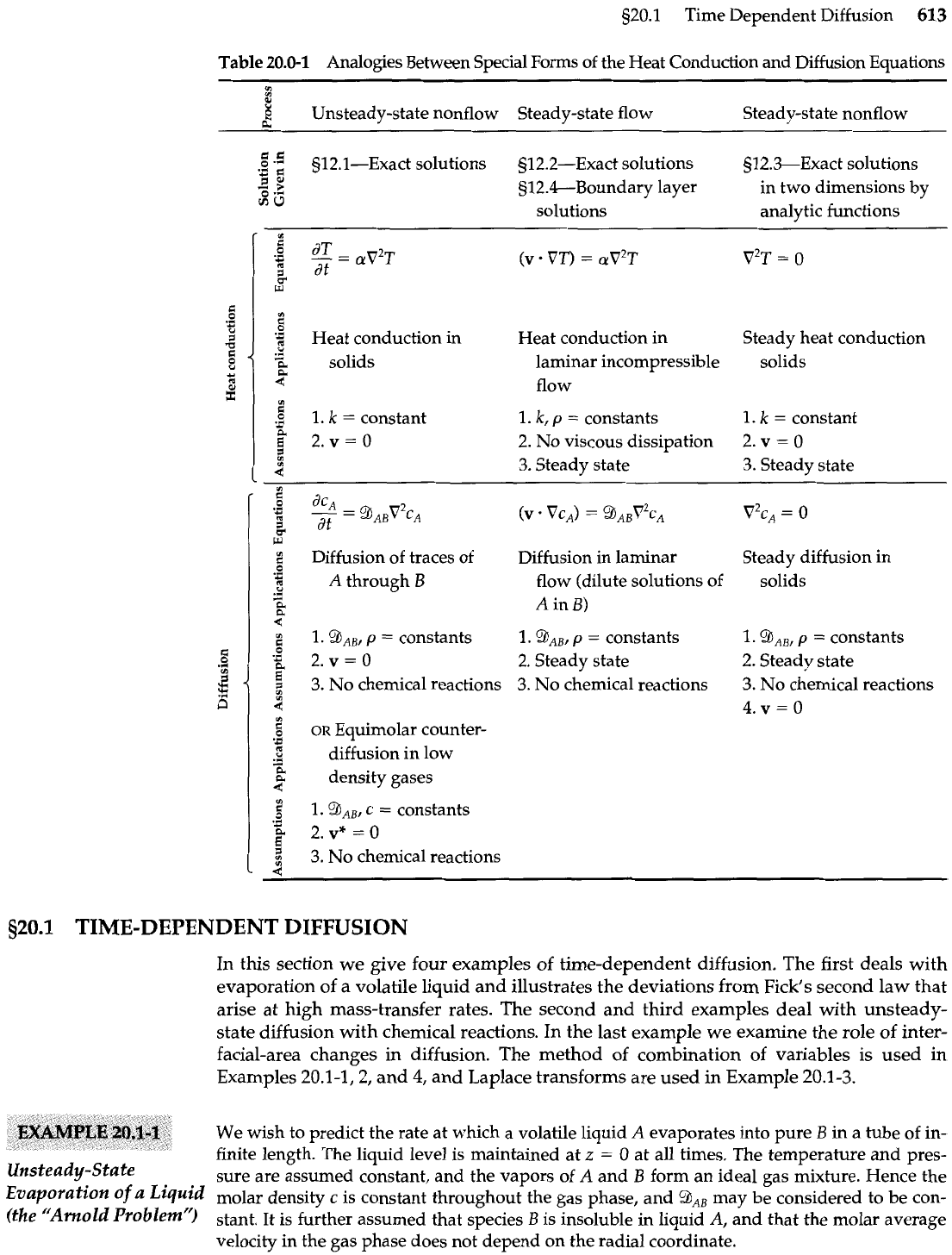
S20.1 Time Dependent Diffusion
613
Table
20.0-1
Analoges Between Special Forms of the Heat Conduction and Diffusion Equations
B
Unsteady-state nonflow Steady-state flow
a
Steady-state nonflow
g
.9
§12.1-Exact solutions 512.2-Exact solutions
.s
fi
s12.3-Exact solutions
I
QJ
+
2
512.4--Boundary layer in two dimensions by
$0
solutions
analytic functions
g
Heat conduction in Heat conduction in Steady heat conduction
b
.A
d
a
solids laminar incompressible solids
9
flow
.
.d
1.
k
=
constant
1.
k,
p
=
constants 1.
k
=
constant
2.v=O
2.
No viscous dissipation 2.
v
=
0
2
4
3.
Steady state
3.
Steady state
2
Diffusion of traces of
'8
A
through
B
.*
-
a
2
1.
%ABr
p
=
constants
8
g
2.v=o
3.
No chemical reactions
4
V)
OR
Equimolar counter-
.*
-
B
.-
4
diffusion in low
a
2
density gases
Diffusion in laminar
Steady diffusion in
flow (dilute solutions of solids
A in
B)
1.
9AB,
p
=
constants
1.
%ABI
p
=
constants
2. Steady state
2.
Steady state
3.
No chemical reactions
3.
No chemical reactions
4.v
=
0
I.
BAB,
c
=
constants
.4
+
2
2.
v*
=
0
5
3.
No chemical reactions
4
$20.1
TIME-DEPENDENT DIFFUSION
In this section we give four examples of time-dependent diffusion. The first deals with
evaporation of a volatile liquid and illustrates the deviations from Fick's second law that
arise at high mass-transfer rates. The second and third examples deal with unsteady-
state diffusion with chemical reactions. In the last example we examine the role of inter-
facial-area changes in diffusion. The method of combination of variables is used in
Examples 20.1-1,2, and
4,
and Laplace transforms are used in Example 20.1-3.
We wish to predict the rate at which a volatile liquid
A
evaporates into pure
B
in
a tube of in-
finite length. The liquid level is maintained at
z
=
0
at all times. The temperature and pres-
Unsteady-State
sure are assumed constant, and the vapors of A and
B
form an ideal gas mixture. Hence the
Evaporation of
a
Liquid
molar density
c
is constant throughout the gas phase, and BAB may be considered to be con-
(the "Amold Problem'')
stant. It is further assumed that species
B
is insoluble in liquid A, and that the molar average
velocity in the gas phase does not depend on the radial coordinate.
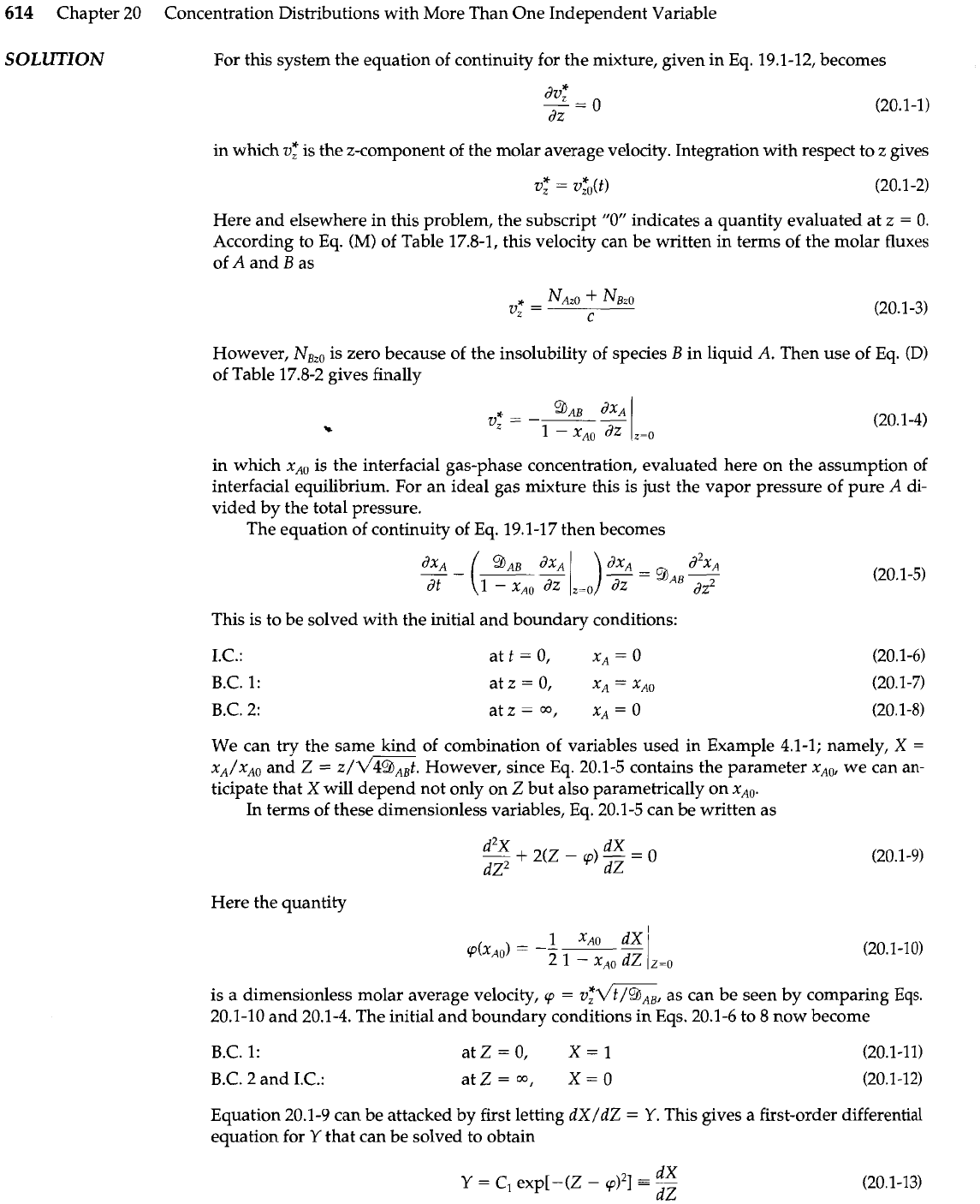
614
Chapter 20 Concentration Distributions with More Than One Independent Variable
SOLUTION
For this system the equation of continuity for the mixture, given in Eq. 19.1-12, becomes
in which
v:
is the z-component of the molar average velocity. Integration with respect to
z
gives
Here and elsewhere in this problem, the subscript
"0"
indicates a quantity evaluated at
z
=
0.
According to
Eq.
(M)
of Table 17.8-1, this velocity can be written in terms of the molar fluxes
of
A
and
B
as
However,
N,,,
is zero because of the insolubility of species
B
in liquid
A.
Then use of Eq.
(D)
of Table 17.8-2 gives finally
in which
XAO
is the interfacial gas-phase concentration, evaluated here on the assumption of
interfacial equilibrium. For an ideal gas mixture this is just the vapor pressure of pure
A
di-
vided by the total pressure.
The equation of continuity of
Eq.
19.1-17 then becomes
This is to be solved with the initial and boundary conditions:
LC.:
B.C. 1:
B.C. 2:
We can try the same kind of combination of variables used in Example 4.1-1; namely,
X
=
xA/xA0
and
Z
=
z/-.
However, since
Eq.
20.1-5 contains the parameter
XA~,
we can an-
ticipate that
X
will depend not only on
Z
but also parametrically on
xAo.
In terms of these dimensionless variables, Eq. 20.1-5 can be written as
Here the quantity
is a dimensionless molar average velocity,
9
=
v:m,
as can be seen by comparing
Eqs,
20.1-10 and 20.1-4. The initial and boundary conditions in Eqs. 20.1-6 to 8 now become
B.C. 1:
B.C. 2 and I.C.:
Equation 20.1-9 can be attacked by first letting
dX/dZ
=
Y.
This gives a first-order differential
equation for
Y
that can be solved to obtain
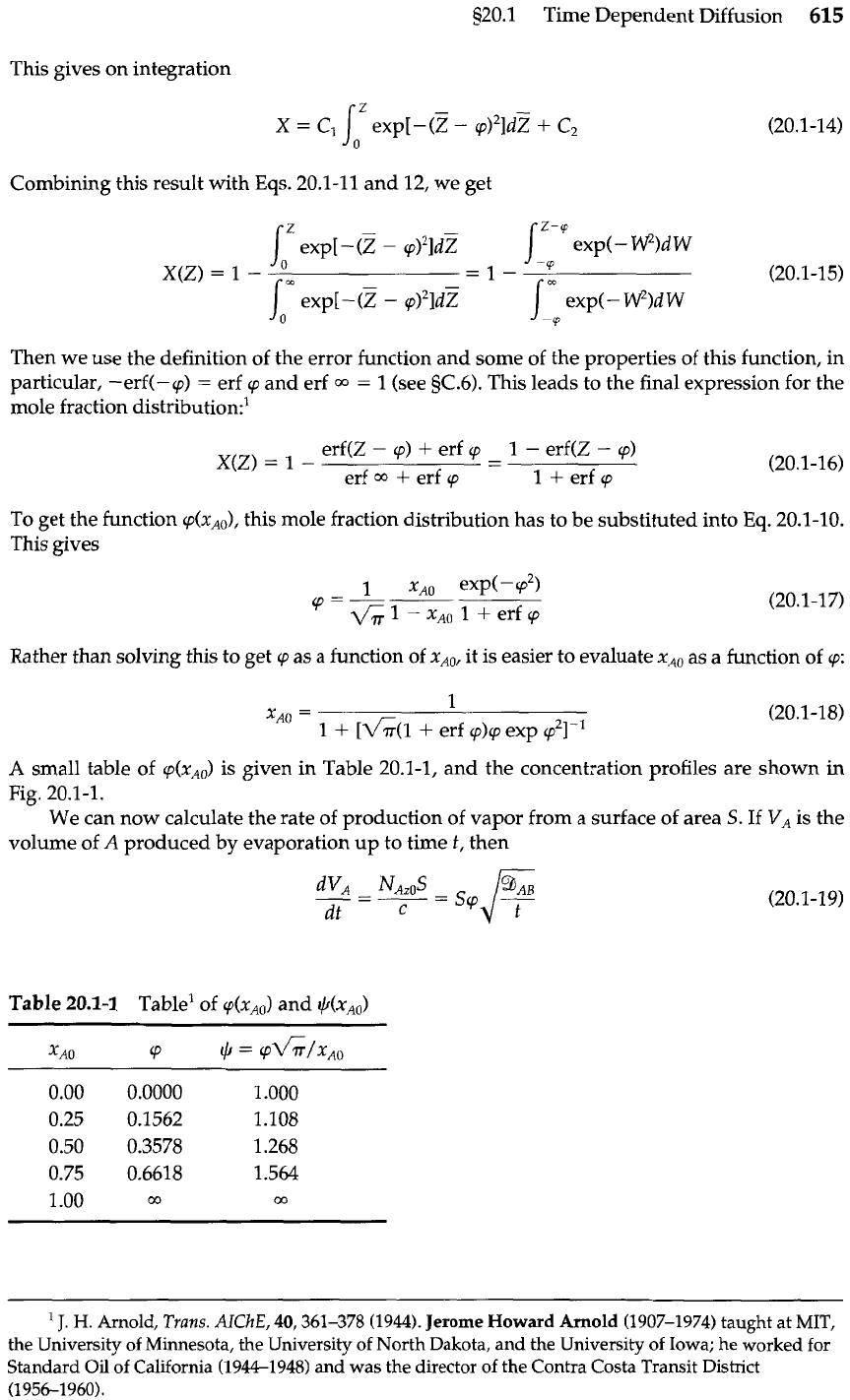
920.1 Time Dependent Diffusion
615
This gives on integration
Combining this result with Eqs. 20.1-11 and 12, we get
Then we use the definition of the error function and some of the properties of this function, in
particular, -erf(-cp)
=
erf
cp
and erf
=
1
(see 5C.6). This leads to the final expression for the
mole fraction distribution:'
erf(Z
-
cp)
+
erf
cp
1
-
erf(Z
-
cp)
X(Z)
=
1
-
-
-
erf
+
erf
cp
1
+
erf
cp
To get the function cp(xA0), this mole fraction distribution has to be substituted into
Eq.
20.1-10.
This gives
Rather than solving this to get
(D
as a function of xAo, it is easier to evaluate xAo as a function of 9:
1
X~~
=
1
+
[l/;f(l
+
erf q)cp exp
cp21-'
A
small table of p(xAo) is given in Table 20.1-1, and the concentration profiles are shown
in
Fig. 20.1-1.
We can now calculate the rate of production of vapor from a surface of area
S.
If
VA
is the
volume of
A
produced by evaporation up to time
t,
then
Table
20.1-1
able'
of (p(xAo) and $(xA,)
'
J.
H.
Arnold,
Trans.
AIChE,
40,361-378 (1944).
Jerome
Howard
Arnold
(1907-1974)
taught at
MIT,
the University of Minnesota, the University
of
North Dakota, and
the
University of Iowa; he worked for
Standard
Oil
of California
(1944-1948)
and was the director of the Contra Costa Transit District
(1956-1960).
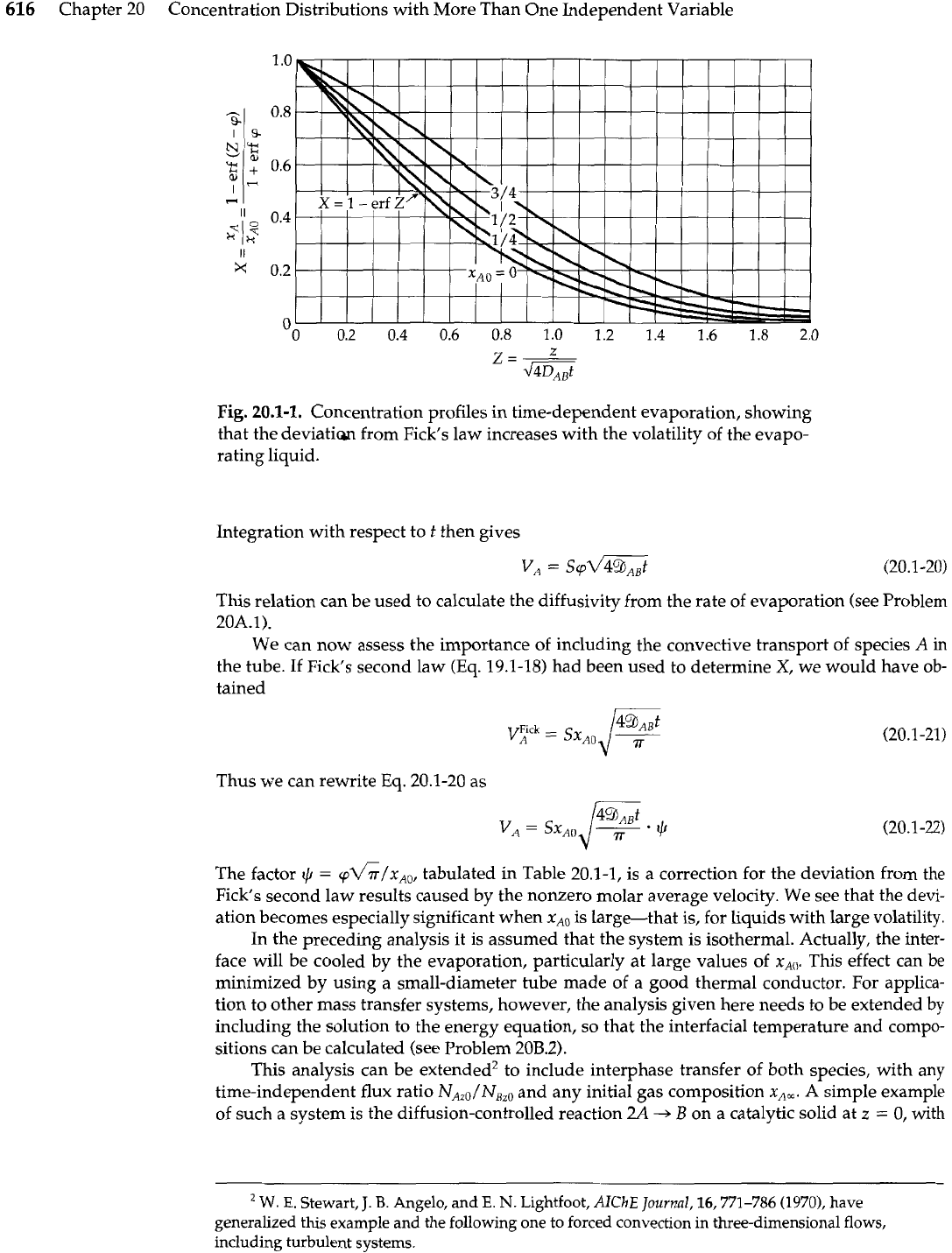
616
Chapter 20 Concentration Distributions with More Than One Independent Variable
Fig. 20.1-1.
Concentration profiles in time-dependent evaporation, showing
that the deviati~ from Fick's law increases with the volatility of the evapo-
rating liquid.
Integration with respect to
t
then gives
This relation can be used to calculate the diffusivity from the rate of evaporation (see Problem
20A.1).
We can now assess the importance
of
including the convective transport of species
A
in
the tube. If Fick's second law
(Eq.
19.1-18) had been used to determine
X,
we would have
ob-
tained
Thus we can rewrite Eq.
20.1-20
as
The factor
I)
=
(Pfi/~AO,
tabulated in Table 20.1-1, is
a
correction for the deviation from the
Fick's second law results caused by the nonzero molar average velocity. We see that the devi-
ation becomes especially significant when
xAO
is large-that is, for liquids with large volatility.
In the preceding analysis it is assumed that the system is isothermal. Actually, the inter-
face will be cooled by the evaporation, particularly at large values of
xA0.
This effect can
be
minimized by using a small-diameter tube made of a good thermal conductor. For applica-
tion to other mass transfer systems, however, the analysis given here needs to be extended
by
including the solution to the energy equation, so that the interfacial temperature and compo-
sitions can be calculated (see Problem 20B.2).
This analysis can be extended2 to include interphase transfer of both species, with any
time-independent flux ratio NAzO/NBzo and any initial gas composition
x,,.
A simple example
of such a system is the diffusion-controlled reaction
2A
-+
B
on a catalytic solid at
z
=
0, with
W.
E.
Stewart,
J.
B.
Angelo, and
E.
N.
Lightfoot,
AlChE
Journal,
16,771-786
(19701,
have
generalized
this
example and the following one to forced convection in three-dimensional flows,
including turbulent
systems.
